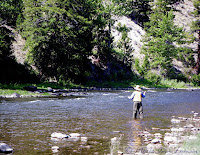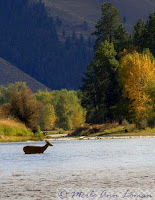
The cloud is actually a spinner fall during a trico hatch
Photo by Merle Ann Loman
Related Articles
- The joys and agonies of trico fishing - companion article #1
- When is the best time to fish western Montana
- Fishing for northern pike on the Bitterroot River
- About Trico - genus Tricorythodes
- Slideshow - photos of trico hatches, rise forms on Montana rivers and more
This article describes Jack's tips to help you reap the rewards and enjoy better success. Jack has broken his tips into six “P”s-- patterns, precision of presentation, patience, persistence, practice, and pulse.
1) Patterns: Having a good trico pattern that will match the hatch is obviously very important. Here is the dilemma. On a typical trico morning trout are on the trico spinner – a spinner imitation is a flat-winged hard to see on the water dry fly which has to be tied fairly sparse. A trico spinner imitation is not only difficult to see, it is not a very good floater. Jack and others have come up with an upright wing parachute tied with a white hackle and a visible antron wing that floats reasonably well. It can be sparsely tied on a 16-20 1X short hook. Unfortunately, over tough educated trout it is the flat winged spinner that will work the best. Jack will change to fresh flies often as these patterns get water-logged after 15 minutes despite a brisk false cast and a shot in the drying crystals.
2) Precision of presentation: You need to have good presentations and that means precision in your casting. No matter how good your pattern is, if it is not placed in front of the feeding trout just right he will not eat it. By just right, Jack means in his lane above his mouth with no drag. This is where having the correct casting angle is paramount. You can be a tournament caster and put the fly on a dime but if the pattern is not cast at the correct angle, it won’t be eaten. Across and down is the technique that lends itself to the most success. In flat, slow moving water casting downstream at an acute 15-20 degree angle will ensure that the trout will see your good pattern before he sees a wad of tippet or your dry fly dragging through the “hold.” It is really easy to have drag on these tiny patterns. The use of a long, fine tippet (3 feet of 6X) can be a benefit but you have to control it while in the air and once it is on the water. The rod tip can help eliminate drag when your fly is on the water by initially creating drag. To do this, you must raise the rod to 10-11 o’clock taking all the slack out of the leader to the fly creating the 15-20 degree angle, then dropping the rod tip and letting the fly do its thing on this long harness. This technique will result in an additional 4-6 inch drift.
You can get away with this “resetting” technique 25-30 feet above the riser without being a tournament caster but it has to be accomplished in a smooth motion. When your fly does start to drag out it is best to let it drag behind your target rather than rip it out of the water to attempt another cast. Remember to strip, strip, strip up line before casting to eliminate noise and surface disturbance.
Sometimes big fish will feed on trico spinners in shallow riffles at the head of pools. In these situations you can decrease the casting angle (to 20-45 degrees) in this faster water but it really helps to have the sun at your back as well. Many times the fish you are after are moving around within the riffle and with all the reflections and refractions, you need all the help you can get to not spook the fish.
A word about leaders around western Montana: When boat fishing, you can get away with a one piece 9 ½ to 10 foot 5X leader. Once out of the boat while wade-fishing, a 12 foot leader with 2-3 feet of 6X tippet will enable one to fish to risers without putting the trout down so long as the fly line is laid down softly with each cast. Because he wants to lay the fly line down very softly, Jack is a big fan of 4 and 5 weight rods. Some even use a 3 weight here.
3 & 4) Persistence and patience: These go hand in hand. It usually takes more than several good drifts to finally get a trout to eat your fly. This does require the utmost in persistence and the patience to wait between casts to let a stubborn trout begin to feed again and cannot be understated. Big selective trout can be extremely rhythmic in their feeding mode, so it does make sense that the timing of your cast is almost as important as the accuracy of delivery. The next dry fly fishing purist book could be entitled “the cadence of trout.” Moral of the story, it doesn’t hurt to observe for a while and not cast. Just wait it out while you observe which lends itself to a little poetry, “to cast or not to cast, that is the question.”
Finally, the hook set itself. Again the word here is patience. Many times Jack has pleaded his “God save the queen” raising of the rod to these words with clients to help slow down their hook sets in order to impale the fish. Because the patterns are tied on small gapped hooks you must be slow and methodical in the hook setting. This is a different hook setting technique than the quick hook set usually associated with nymph and bobber rigs and/or larger dry fly fishing. This technique can’t be learned over night. It requires practice.
5) Practice: Yes, he said practice. It does take practice to get good at anything difficult. To truly master this type of trout fishing it is somewhat synonymous with a great hitter in baseball. There are times when you may go into a slump. You aren’t going to get a hit every time at bat, but your percentage of success will improve with practice.
6) Pulse: The pulse of tricos is affected by weather. The best weather patterns that bring on consistent spinner falls are windless, warm partly sunny days. A stable high pressure dome sitting over the Rockies will get trout into a predictable morning feeding rhythm. A change to cool rainy weather will disrupt your spinner falls and cause a down pulse.
In conclusion, you can be doing everything right, make good presentation, hook a beautiful fish with a nice slow hook set, play him for one long run and then have him shake the hook or break off in a weed bed. This is where the joy can turn to agony. But therein lies the challenge of what trout fishing is all about. Hopefully these tips can help you catch more trout during trico time.
Wapiti Waters Fly Fishing Montana – Seasonal hatch primer for western Montana
Westfly Entomology – For the western fly fishing community
Merle’s SmugMug photo site – More river and fishing photos in their original format Incudes Big Hole, Bitterroot, Blackfoot, Clark Fork, and Missouri rivers during the months of March through November with captions
Merle's SmugMug trico photos - better resolution
If you like these articles, be the first to see them, subscribe by email (see above), by RSS, Twitter, or Facebook.








